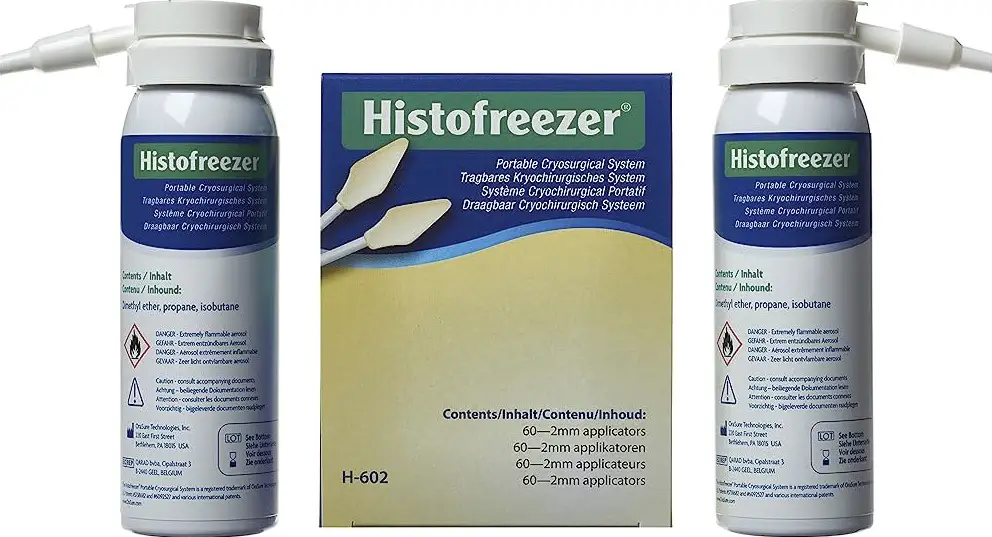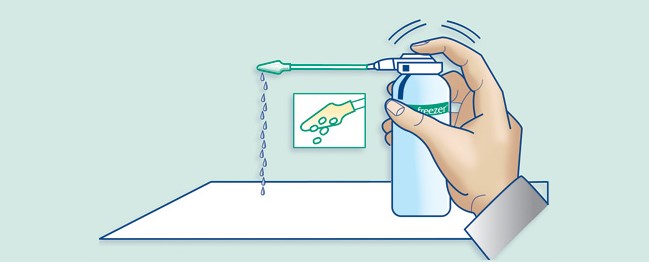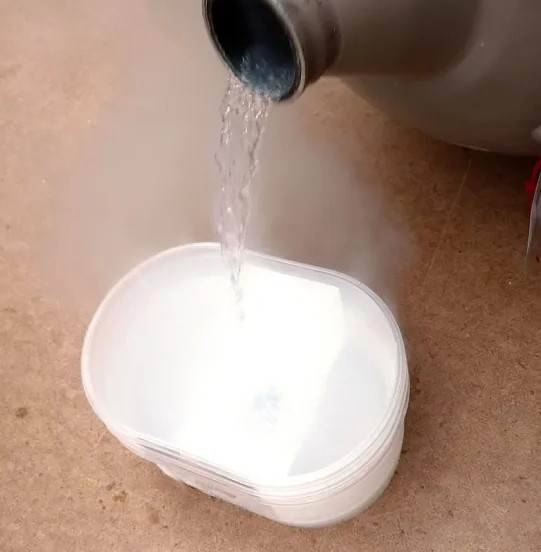The quest for effective skin lesion treatments has led to the development and adoption of various methodologies, with cryotherapy standing out as a highly preferred option. This technique, which involves the application of extreme cold to destroy abnormal tissue, leverages different agents, the most notable being Histofreezer and Liquid Nitrogen. Their application in medical practice has revolutionized the approach towards the treatment of various skin conditions, offering solutions that are both effective and minimally invasive.
Histofreezer and Liquid Nitrogen, while serving the same purpose in cryotherapy, operate under distinct principles and possess unique characteristics. Histofreezer is a portable cryosurgical system that uses a proprietary blend to achieve freezing temperatures, making it suitable for treating smaller lesions. Liquid Nitrogen, on the other hand, is a more aggressive cryogen that can achieve much lower temperatures, making it effective for a wider range of skin lesions, including larger and more complex ones.
The choice between Histofreezer and Liquid Nitrogen hinges on several factors including the nature and size of the lesion, patient sensitivity, and the clinical setting. Histofreezer offers the convenience of portability and ease of use, making it ideal for treatments in settings where Liquid Nitrogen’s storage requirements cannot be met. Liquid Nitrogen, with its broader applicability, remains the go-to option for more extensive lesions requiring deeper tissue penetration. Understanding their differences is crucial for clinicians and patients alike in choosing the most appropriate treatment method.

Cryotherapy Explained
What is Cryotherapy?
Cryotherapy, a term derived from the Greek words “cryo” meaning cold and “therapy” meaning cure, refers to a medical treatment that uses extreme cold to freeze and eliminate abnormal tissue. The technique can target a wide range of conditions, from skin lesions and warts to precancerous cells and small tumors. By applying sub-zero temperatures, cryotherapy causes the water in the targeted cells to freeze, leading to cell death and ultimately, the removal of unwanted tissue.
Benefits of Cryotherapy
The benefits of cryotherapy are multifaceted, making it a preferred treatment option for various dermatological and medical conditions. Among its advantages are:
- Minimal invasiveness: Cryotherapy is a non-surgical method, which means it typically requires no cuts or incisions.
- Quick procedures: Most treatments are fast, sometimes taking only a few minutes.
- High effectiveness: It is effective in removing many types of skin lesions and some types of cancer cells with a high success rate.
- Reduced side effects: Compared to other treatments, cryotherapy has fewer side effects, with most patients experiencing only minor discomfort.
- Fast recovery: Recovery time is minimal, allowing patients to resume their daily activities shortly after treatment.
Histofreezer Overview
What is Histofreezer?
Histofreezer is a portable cryosurgery system designed for the treatment of various skin lesions, such as warts, skin tags, and actinic keratoses. It uses a mixture of dimethyl ether and propane to create cold temperatures that can effectively destroy targeted tissue. Its portable nature makes it a convenient option for both doctors in clinical settings and for use in remote areas or field settings.
Components and Mechanism
The Histofreezer system comprises a canister filled with a cryogenic solution, applicator tips of various sizes, and a holder. The mechanism of action involves:
- Attaching an applicator tip to the canister.
- Spraying the solution into the tip to cool it down.
- Applying the tip to the lesion to freeze it.
This process causes cell damage by freezing the water inside the cells, leading to cell death and the eventual shedding of the lesion.
Uses and Benefits
Histofreezer offers several benefits over traditional cryotherapy methods:
- Ease of use: Its simplicity makes it accessible for healthcare providers without specialized training in cryotherapy.
- Safety: The system is designed to minimize the risk of damage to surrounding healthy tissue.
- Portability: Its compact size allows for easy transportation and use in various settings.
- Cost-effective: Histofreezer is often more affordable than other cryotherapy methods, especially in settings with limited resources.
Liquid Nitrogen Overview
What is Liquid Nitrogen?
Liquid nitrogen (LN2) is a cryogenic liquid with a temperature of approximately -196°C (-321°F). In the medical field, it is widely used in cryotherapy for its ability to rapidly freeze and destroy unwanted tissues. Its extreme cold temperature makes it highly effective for a broad range of dermatological conditions.
Application in Cryotherapy
Liquid nitrogen is applied directly to the skin lesions using a cotton swab or a spray device. This application method allows for precise control over the area being treated, ensuring that only the targeted tissue is affected. The extreme cold causes immediate freezing of the water within the cells, leading to cell death and the eventual removal of the lesion.
Uses and Benefits
Liquid nitrogen cryotherapy is beneficial for:
- Wide range of applications: Effective for a variety of skin conditions, including warts, moles, and precancerous lesions.
- Precision: The ability to target lesions accurately without affecting surrounding tissue.
- Effectiveness: High success rates in removing unwanted tissue.
- Rapid action: Quick freezing leads to fast treatment times.
Key Differences
Comparison Criteria
When comparing Histofreezer and liquid nitrogen, several criteria are considered, including temperature profiles, application methods, safety, side effects, effectiveness, and treatment areas.
Temperature Profiles
- Histofreezer typically reaches temperatures around -55°C to -60°C (-67°F to -76°F).
- Liquid nitrogen goes down to about -196°C (-321°F), offering a much colder treatment option.
Application Methods
- Histofreezer uses a portable canister with applicator tips for direct application.
- Liquid nitrogen may be applied with a spray device or a cotton swab, requiring more careful handling due to its extremely low temperature.
Safety and Side Effects
- Histofreezer is considered safe with minimal risk of side effects, primarily due to its higher temperature compared to liquid nitrogen.
- Liquid nitrogen, while effective, poses a higher risk of burns and damage to surrounding tissue if not applied precisely.
Effectiveness and Treatment Areas
- Histofreezer is effective for small, superficial skin lesions but may not be as effective for deeper or larger lesions.
- Liquid nitrogen is highly effective for a broader range of lesions, including those that are larger or deeper, due to its lower temperature and deeper penetration.

Advantages and Limitations
Histofreezer Advantages
Histofreezer offers several key advantages that make it an appealing option for treating skin lesions. These include:
- Portability: Its compact size allows healthcare providers to easily carry it to different locations, making it especially useful in remote areas or for home visits.
- Ease of Use: With a simple mechanism, it requires minimal training, allowing a wide range of healthcare professionals to use it effectively.
- Safety: The risk of damaging surrounding healthy tissue is lower compared to treatments that use lower temperatures.
- Quick Procedure: Treatments are brief, often lasting just a few seconds to a minute, enhancing patient throughput in clinics.
Liquid Nitrogen Advantages
Liquid nitrogen, on the other hand, presents its own set of advantages, including:
- Versatility: It can treat a wide array of lesions, from superficial to deeper ones, due to its extremely low temperature.
- Efficacy: Offers a high success rate, especially for stubborn or recurrent lesions, by providing a deeper freeze.
- Precision: When applied with proper technique, it allows for accurate targeting of lesions without affecting adjacent areas.
Limitations of Histofreezer
Despite its benefits, Histofreezer has limitations:
- Depth of Freeze: May not be effective for deeper or larger skin lesions due to its relatively higher freezing point.
- Repeat Treatments: Some lesions might require multiple sessions to achieve complete removal.
Limitations of Liquid Nitrogen
Liquid nitrogen also has its downsides:
- Risk of Skin Damage: The extreme cold can cause burns or scars if not applied carefully.
- Equipment Requirements: Requires storage in special containers and careful handling, limiting its use to settings where such infrastructure is available.
Practical Considerations
Cost Comparison
When considering cost:
- Histofreezer tends to be more budget-friendly for small-scale applications due to its portability and ease of use.
- Liquid Nitrogen might involve higher initial setup costs (for equipment and storage) but can be more cost-effective in high-volume settings due to the lower cost of liquid nitrogen itself.
Accessibility and Storage
- Histofreezer is readily accessible due to its portable design and does not require special storage conditions, making it suitable for various clinical settings.
- Liquid Nitrogen requires a cryogenic storage tank and careful handling, which might limit its accessibility in resource-constrained settings.
Training and Expertise Required
- Histofreezer can be used with minimal training, broadening its accessibility among healthcare providers.
- Liquid Nitrogen demands more specialized training to avoid the risk of tissue damage, making it more suited for use by dermatologists or trained healthcare professionals.
Patient Experience
Pain and Discomfort Levels
- Histofreezer treatments are generally well tolerated, with patients reporting minimal discomfort due to the brief and controlled application.
- Liquid Nitrogen may cause a more intense cold sensation during treatment, potentially leading to greater discomfort but usually remains manageable.
Healing and Recovery Time
- Histofreezer typically results in a quick healing process, with most lesions healing within one to two weeks.
- Liquid Nitrogen, due to its deeper freeze, might lead to longer healing times, especially for larger or deeper lesions, but this is balanced by its efficacy in treating difficult lesions.
Patient Satisfaction
- Histofreezer patients often express high satisfaction due to the quick, convenient, and relatively painless nature of the treatment.
- Liquid Nitrogen patients appreciate the high effectiveness of the treatment, even if it might involve slightly more discomfort or longer healing times. The satisfaction often correlates with the success in removing the targeted lesion.
Frequently Asked Questions
What is Cryotherapy?
Cryotherapy is a treatment method that involves the use of extreme cold to destroy abnormal or diseased tissue. It is commonly used for skin lesions, including warts, moles, and skin tags, as well as for certain types of cancer. The process works by freezing the cells in the targeted tissue, causing them to die and eventually be absorbed by the body.
How do Histofreezer and Liquid Nitrogen differ in application?
Histofreezer and Liquid Nitrogen differ significantly in their application methods. Histofreezer is applied using a portable device that sprays a freezing agent directly onto the lesion, making it well-suited for treating smaller, more superficial lesions. Liquid Nitrogen, however, is typically applied using a cotton swab or a spray, allowing for a more controlled and deeper freeze, which is necessary for treating larger or deeper skin conditions.
Are there any side effects associated with cryotherapy?
Yes, cryotherapy can have side effects, though they are generally mild and temporary. Common side effects include redness, swelling, blistering, and discomfort at the treatment site. Rarely, more severe side effects can occur, such as scarring, changes in skin color, or damage to surrounding healthy tissue. The risk of side effects varies depending on the cryogen used and the depth of the treatment.
Can all skin lesions be treated with Histofreezer or Liquid Nitrogen?
Not all skin lesions are suitable for treatment with Histofreezer or Liquid Nitrogen. The choice of treatment depends on the type, size, and location of the lesion, as well as the patient’s overall health and skin type. While both treatments are effective for a wide range of conditions, a healthcare provider can determine the most appropriate method based on a thorough evaluation of the lesion.
Conclusion
In the realm of dermatological treatments, the choice between Histofreezer and Liquid Nitrogen is emblematic of the balance between convenience and efficacy. Each method carries its set of advantages and limitations, tailored to meet the diverse needs of patients and practitioners. The decision on which to use should be guided by a comprehensive assessment of the lesion, patient preferences, and clinical objectives.
Ultimately, the evolution of cryotherapy techniques, exemplified by Histofreezer and Liquid Nitrogen, underscores a commitment to improving patient care through innovation. As the field advances, ongoing research and clinical experience will continue to refine these treatments, ensuring that patients receive the most effective and personalized care possible.

